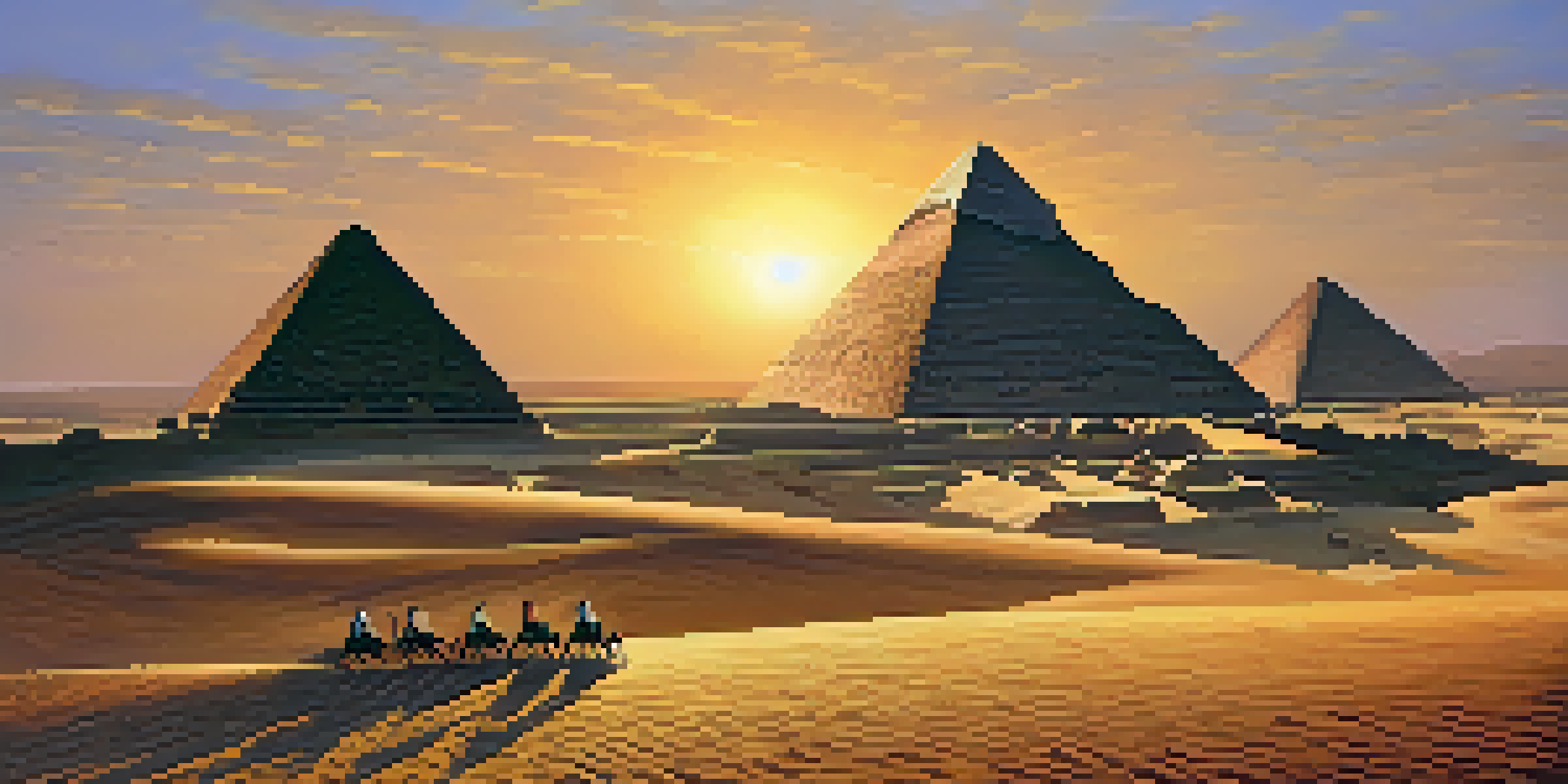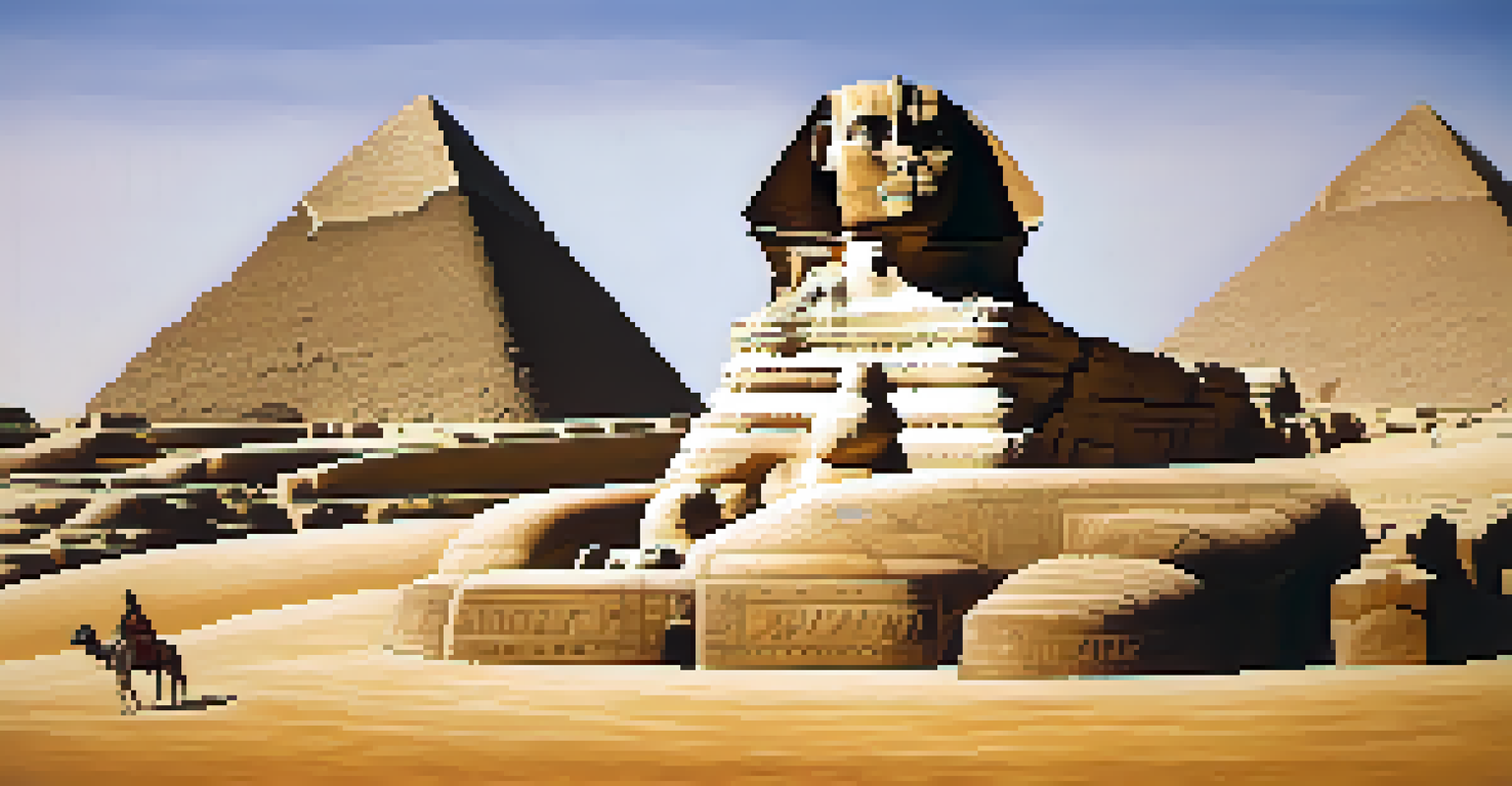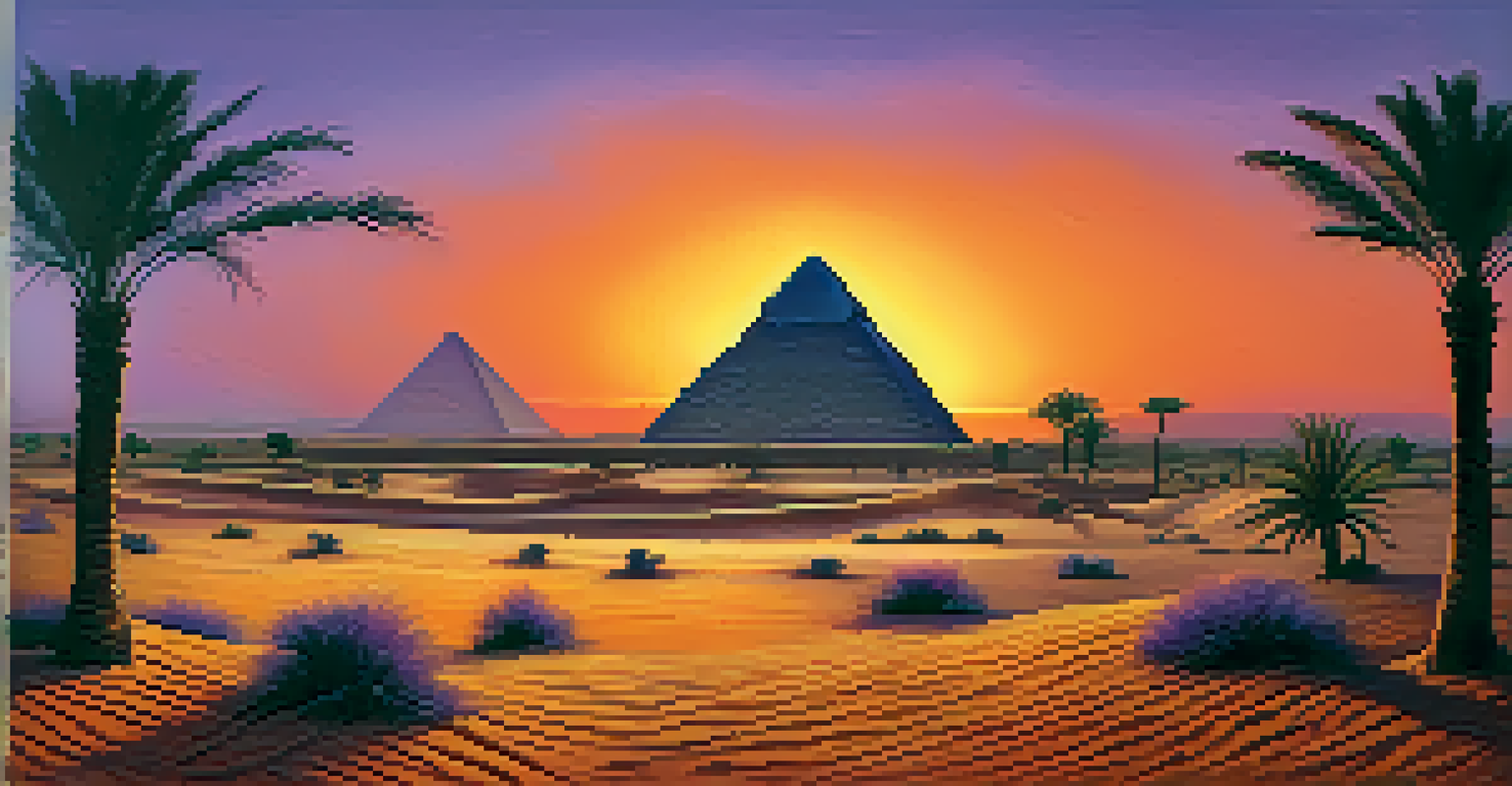Visiting the Pyramids of Giza: Egypt's Timeless Marvels

The Magnificent Pyramids: A Brief Overview
The Pyramids of Giza, located on the outskirts of Cairo, are one of the most iconic symbols of ancient Egypt. Built over 4,500 years ago, these monumental structures were created as tombs for pharaohs, showcasing the incredible engineering skills of their time. The three main pyramids: Khufu, Khafre, and Menkaure, each tell a story of ambition and power, reflecting the grandeur of the civilization that built them.
The pyramids are a reminder that human ingenuity and creativity can overcome the most daunting challenges.
The Great Pyramid of Khufu, also known as the Pyramid of Cheops, is the largest and most famous of the three. It originally stood at 146.6 meters tall and was the tallest man-made structure in the world for over 3,800 years. Today, it remains a testament to the ingenuity of ancient architects and continues to captivate millions of visitors each year.
As you stand before these colossal structures, it's impossible not to feel a sense of awe and wonder. The sheer size and precision of the pyramids are remarkable, inviting you to ponder how ancient Egyptians accomplished such feats without modern technology. They are indeed timeless marvels that bridge the gap between the past and the present.
Planning Your Visit: Tips and Best Times
When planning a visit to the Pyramids of Giza, timing is key. The best months to visit are between October and April when the weather is cooler and more comfortable for exploring. Arriving early in the morning or later in the afternoon allows you to avoid the peak crowds and enjoy a more serene experience with fewer distractions.

It's also wise to consider booking a guided tour, which can enhance your understanding of the pyramids' history and significance. Many tours offer insights that you might miss when exploring on your own, including fascinating stories about the pharaohs and the construction of these ancient wonders. Plus, a knowledgeable guide can help navigate the site and answer any questions you may have.
Visit the Pyramids in Cooler Months
The best time to explore the Pyramids of Giza is from October to April when the weather is milder and more enjoyable for visitors.
Don’t forget to wear comfortable shoes and bring plenty of water! The area around the pyramids can be quite expansive, and walking around in the sun can be taxing. Being prepared will ensure you have a more enjoyable visit as you soak in the breathtaking views and rich history surrounding these incredible structures.
What to Expect: Exploring the Giza Plateau
As you step onto the Giza Plateau, you'll find yourself surrounded by a landscape that feels almost otherworldly. The vast desert stretches out before you, with the pyramids majestically rising against the skyline. The atmosphere is imbued with a sense of history, making it easy to imagine the grand ceremonies that once took place here.
Traveling – it leaves you speechless, then turns you into a storyteller.
Take your time to explore not just the pyramids, but also the nearby Sphinx. This enigmatic statue, with the body of a lion and the head of a pharaoh, adds another layer of intrigue to your visit. Many believe it symbolizes strength and wisdom, serving as a guardian to the sacred sites of Giza.
As you wander, keep your camera ready! The interplay of light and shadow on the pyramids during sunrise or sunset can create stunning photographs, capturing the essence of this ancient wonder. Each angle offers a different perspective, making the experience even more memorable.
Cultural Etiquette: Respecting Egyptian Traditions
When visiting the Pyramids of Giza, it's important to approach the site with respect for the local culture and traditions. Egyptians are known for their hospitality, and a friendly greeting can go a long way. Learning a few basic Arabic phrases, such as 'hello' or 'thank you,' can enhance your interactions with locals and show appreciation for their culture.
Additionally, dress modestly, especially when visiting religious sites or interacting with local communities. While the pyramids themselves are more tourist-focused, being mindful of cultural norms demonstrates respect and helps foster positive relationships. Lightweight, breathable clothing is ideal, given the warm climate.
Respect Local Culture and Etiquette
When visiting, it's essential to engage respectfully with local traditions and dress modestly to honor the culture of Egypt.
Lastly, be conscious of the environment. The Giza Plateau is a precious historical site, and it's essential to leave no trace behind. Properly disposing of trash and being respectful of the area ensures that future generations can also experience the wonders of these ancient marvels.
Unveiling Myths: The Secrets of the Pyramids
The Pyramids of Giza have sparked countless myths and theories over the centuries. From tales of alien construction to theories about hidden treasures, the pyramids have become a canvas for imagination. However, the truth is that they were built using human ingenuity, labor, and a deep understanding of mathematics and astronomy.
One popular myth is that the pyramids were constructed by slaves; however, evidence suggests that skilled workers labored on these monumental structures. These workers were likely well-fed and housed, as the construction took decades and required a dedicated workforce. Understanding this aspect adds depth to your appreciation of the pyramids' history.
Exploring these myths and separating fact from fiction can enrich your visit. Engaging with local guides who can share their insights and knowledge will help demystify the pyramids and provide a clearer picture of their historical context.
Beyond the Pyramids: Nearby Attractions
While the Pyramids of Giza are undoubtedly the main attraction, there's so much more to explore in the surrounding area. The Solar Boat Museum, located near the Great Pyramid, showcases an ancient vessel that was buried alongside the pharaoh. This beautifully preserved boat offers a glimpse into the burial practices of ancient Egyptians and their beliefs about the afterlife.
Additionally, don't miss the opportunity to visit the nearby Saqqara, home to the Step Pyramid of Djoser. This pyramid is considered the earliest large-scale cut stone construction, marking a significant evolution in architectural design. The site is less crowded and allows for a more intimate exploration of Egypt's rich history.
Support Conservation Efforts
Being mindful of your impact during your visit helps contribute to the ongoing conservation efforts that protect the Pyramids of Giza for future generations.
Lastly, the bustling Khan el-Khalili bazaar in Cairo is a must-see for those looking to immerse themselves in local culture. Here, you can shop for souvenirs, sample local cuisine, and engage with the vibrant atmosphere, making it a perfect end to your day of exploring the pyramids.
Preserving the Legacy: The Importance of Conservation
As one of the most significant archaeological sites in the world, the Pyramids of Giza face numerous challenges in terms of preservation. Increased tourism, pollution, and natural wear and tear all pose threats to these ancient structures. Efforts are ongoing to protect and maintain the pyramids, ensuring they remain a source of wonder for future generations.
Organizations and local authorities are implementing various conservation measures, such as limiting the number of visitors at certain times and promoting sustainable tourism practices. By being mindful of your impact during your visit, you can contribute to these efforts and help preserve the integrity of this historical treasure.

Understanding the importance of conservation can deepen your appreciation for the pyramids. Each visit is not just a chance to marvel at their grandeur but also an opportunity to support the ongoing efforts to protect Egypt's rich heritage and ensure that these timeless marvels endure.